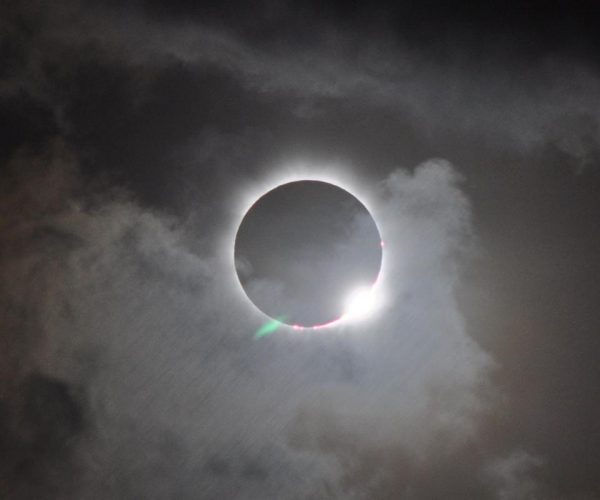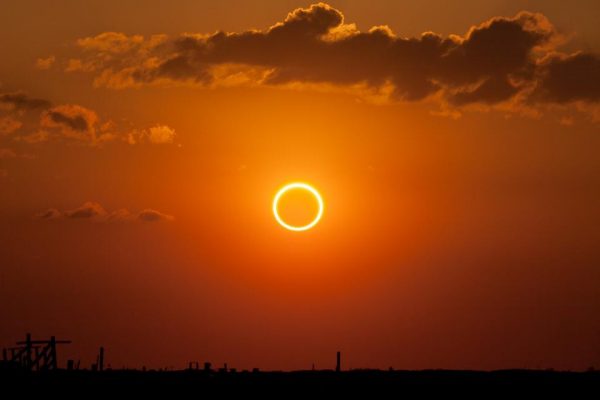"We live in a moment of history where change is so speeded up that we begin to see the present only when it is already disappearing." -R. D. Laing
This coming Monday, tens of millions of people will gather to watch the total solar eclipse that will go coast-to-coast across the continental United States. Total solar eclipses like this happen, on average, about once every 18 months, due to the frequency of alignment as well as the Moon’s apparent angular size. At present, about 40% of all solar eclipses are total eclipses, with annular eclipses making up 50% and hybrid eclipses the other 10%.
 The Moon and Sun each take up approximately half a degree on the sky as viewed from Earth. When the Moon is slightly larger in angular size than the Sun is and all three bodies perfectly align, a total solar eclipse is the result. Image credit: Romeo Durscher / NASA / Goddard Space Flight Center.
The Moon and Sun each take up approximately half a degree on the sky as viewed from Earth. When the Moon is slightly larger in angular size than the Sun is and all three bodies perfectly align, a total solar eclipse is the result. Image credit: Romeo Durscher / NASA / Goddard Space Flight Center.
However, this ratio has changed with time, and will continue to change. The Moon is migrating farther away from Earth, and annular eclipses are becoming more common, while total eclipses are becoming more rare. Although the migration rate is small -- mere centimeters per year -- that adds up over millions of years. At some point in the future, the Moon’s shadow will be completely unable to fall on Earth’s surface any longer.


Okay, so I still have a solid half-billion years to catch one. Cool!
I seriously hope in a million years they get really worried about this. In the meantime...not so much.
@Ethan wrote:
I'm not sure that is correct and I'm not even sure science has it completely figured out. From what I understand Earth sits just inside the radius they expect the sun to swell to in the Red Giant phase, however the central star in the Reg Giant phase loses mass thereby decreasing its gravity which some theorize could cause the orbit of Earth to drift outward enough to possibly survive.
If Earth is not engulfed by the Sun, it has two things working for it. First the White Dwarf will be smaller than the sun is now. Secondly, the Earth's Moon is never going to escape. Eventually it will reach a maximum distance and ever so slowly start to spiral inward. In the far, far distant future, if the Earth and Moon survive the Red Giant phase, the orbit will decay enough that the Moon will crash into the Earth. Before that happens there will be plenty of Solar Eclipses on our long dead world.
The sun is also swelling due to evolution. As I understand it at this epoch, the surface temperature stays nearly constant, but the radius must increase to accommodate the increasing luminosity. Both the sun growing fatter, as well as the moon looking smaller push towards annular eclipse. Maybe it will happen faster than your calculation has it (assuming you only used one factor)?
I just hope the weather provides clear viewing conditions for this one!
The increase of the Sun's radius due to solar evolution has a significant effect, too. Using the evolutionary models of from the Dartmouth Stellar Evolution website, one can show that the last total eclipse will occur around 450 million years in the future.
In the figure below, the solid lines indicate the minimum angular sizes of Sun and Moon (due to eccentricity of Earth's and Moon's orbit, respectively), and dotted lines indicate the maximum angular sizes.
http://spiff.rit.edu/richmond/temp/sunmoon_a_color.png
Mousie lives a considerable distance from the total eclipse. However, Mousie has discovered an inexpensive, safe and convenient method of experiencing the thrills of the total eclipse. Mousie will get into bed and pull the covers over Mousie's head, simulating the darkness of the eclipse. In fact, Mousie may experience a total eclipse that lasts for several hours. ========== Love, Mousie